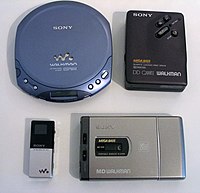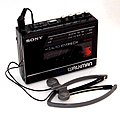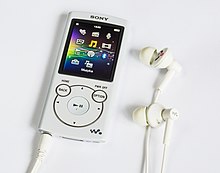Walkman
 | |
 Walkman logo (1981-2000; 2000-present) Various Walkman products; clockwise from top-left: a CD Walkman, a DD (cassette) Walkman, an MD Walkman (MiniDisc), an FM Walkman (radio) | |
| Manufacturer | Sony |
|---|---|
| Type | Portable media player |
| Lifespan | July 1, 1979 – October 25, 2010 (Compact Cassette Edition); Approximately 1979 (AM/FM radio); July 1, 1984 – present (all other editions) |
| Units sold | 385 million (all editions, as of March 31, 2009)[1] |
| Related articles | |
Walkman (stylized WALKMAN) is a brand of portable media players manufactured by Sony. The original Walkman, released in 1979, was a portable cassette player that allowed people to listen to music of their choice on the move.[2][3] Its popularity made "walkman" an unofficial term for personal stereos of any producer or brand.[4] By 2010, when production stopped, Sony had built about 200 million cassette-based Walkmans.[5]
The Walkman brand was extended to serve most of Sony's portable audio devices as well as related media devices. The name has been used on portable DAT players, MiniDisc players/recorders, CD players (originally Discman then renamed the CD Walkman), radio receivers, Sony's line of digital audio and media players, mobile phones and more.[6][7] As of 2020, only digital audio and media players are currently in production.
Development[]

The first Walkman prototype was built from a modified Sony Pressman,[8][failed verification] a compact cassette recorder designed for journalists and released in 1977.[9][failed verification]
The metal-cased blue-and-silver Walkman TPS-L2, the world's first low-cost personal stereo, went on sale in Japan on July 1, 1979, and was sold for around ¥33,000 (or $150.00).[10] Though Sony predicted it would sell about 5,000 units a month, it sold more than 30,000 in the first two months.[8]
The Walkman was followed by a series of international releases; as overseas sales companies objected to the wasei-eigo name, it was sold under several names, including Soundabout in the United States, Freestyle in Australia and Sweden, and Stowaway in the UK.[11][12] Eventually, in the early 1980s, Walkman caught on globally and Sony used the name worldwide. The TPS-L2 was introduced in the US in June 1980.[8]

The 1980s was the decade of the intensive development of the Walkman lineup. In 1981 Sony released the second Walkman model, the WM-2, which was significantly smaller compared to the TPS-L2 thanks to "inverse" mounting of the power-operated magnetic head and soft-touch buttons. The first model with Dolby noise-reduction system appeared in 1982. [13] The first ultra-compact "cassette-size" Walkman was introduced in 1983, model WM-20, with a telescopic case. This allowed even easier carrying of a Walkman in bags or pockets.[14] The first model with autoreverse was released in 1984.[15]
In October 1985, the WM-101 model was the first in its class with a "gum stick" rechargeable battery.[14] In 1986 Sony presented the first model outfitted with remote control, as well as one with a solar battery (WM-F107).
Within a decade of launch, Sony held a 50% market share in the United States and 46% in Japan.[16]
Two limited edition 10th anniversary models were released in 1989 (WM-701S/T) in Japan, made of brass and plated in sterling silver. Only a few hundred were built of each.[17] A 15th anniversary model was also made on July 1, 1994, with vertical loading,[18] and a 20th anniversary on July 1, 1999, with a prestige model.
By 1989, 10 years after the launch of the first model, over 100 million Walkmans had been sold worldwide.[19] 150 million units were manufactured by 1995.[20] By 1999, 20 years after the introduction of the first model, Sony sold 186 million cassette Walkmans.[21]
Portable compact disc players led to the decline of the cassette Walkman,[22] which was discontinued in Japan in 2010.[23] The last cassette-based model available in the US was the WM-FX290W -[24][25] this model was first released 2004.[26]

Second generation budget Walkman model from 1983 (model WM-4)

WM-F5 "Okinawa" Sports Walkman

WM-75 Walkman "Sports" model (1985)

Walkman professional with Dolby B and C, model WM-D6C, 1985–1999

Model WM-F77, c. 1986

WM-B603 (1989)

WM-F404, high-end model with TV tuner (1990)

A "Sport" Walkman model from the early 90s

A 90s Walkman with a combined radio

Mid-1990s Walkman (WM-EX116) with supplied headphones

Sony Walkman WM-EX194 (2004)
Marketing[]

The marketing of the Walkman helped introduce the idea of "Japanese-ness" into global culture, synonymous with miniaturization and high-technology.[27] The "Walk-men" and "Walk-women" in advertisements were created to be the ideal reflections of the viewing audience.[28]
A major component of the Walkman advertising campaign was personalization of the device. Prior to the Walkman, the common device for portable music was the portable radio, which could only offer listeners standard music broadcasts.[29] Having the ability to customize a playlist was a new and exciting revolution in music consumption. Potential buyers had the opportunity to choose their perfect match in terms of mobile listening technology. The ability to play one's personal choice of music and listen privately was a huge selling point of the Walkman, especially amongst teens, who greatly contributed to its success.[29] A diversity of features and styles suggested that there would be a product which was "the perfect choice" for each consumer.[30] This method of marketing to an extremely expansive user-base while maintaining the idea that the product was made for each individual "[got] the best of all possible worlds—mass marketing and personal differentiation".[30]
Impact and legacy[]
Culturally the Walkman had a great effect and it became ubiquitous.[31] According to Time, the Walkman's "unprecedented combination of portability (it ran on two AA batteries) and privacy (it featured a headphone jack but no external speaker) made it the ideal product for thousands of consumers looking for a compact portable stereo that they could take with them anywhere".[8] According to The Verge, "the world changed" on the day the Walkman was released.[32]
The Walkman became an icon in 1980s culture.[8] In 1986, the word "Walkman" entered the Oxford English Dictionary.[8] Millions used the Walkman during exercise, the marking the beginning of the aerobics craze.[8] Between 1987 and 1997, the height of the Walkman's popularity, the number of people who said they walked for exercise increased by 30%.[8] Other firms, including Aiwa, Panasonic and Toshiba, produced similar products, and in 1983 cassettes outsold vinyl for the first time.[8]
The Walkman has been cited to not only change people's relationship to music but also technology, due to its "solitary" and "personal" nature, as users were listening to their own music of choice rather than through a radio. It has been seen as a precursor of personal mainstream tech possessions such as personal computers or mobile phones.[33] Headphones also started to be worn in public. This caused safety controversies in the US, which in 1982 led to the mayor of Woodbridge, New Jersey banning Walkman to be worn in public due to pedestrian accidents.[34]
In the market, the Walkman's success also led to great adoption of the Compact Cassette format. Within a few years, cassettes were outselling vinyl records, and would continue to do so until the compact disc (CD) overtook cassette sales in 1991.[35][36]
In German-speaking countries, the use of "walkman" became generic, meaning a personal stereo of any make, to a degree that the Austrian Supreme Court of Justice ruled in 2002 that Sony could not prevent others from using the term "walkman" to describe similar goods. It is therefore an example of what marketing experts call the "genericide" of a brand.[4]
A large statue of a Sports Walkman FM was erected in Tokyo's Ginza district in 2019 in celebration of the 40th anniversary.[37]
Successors[]

In 1989, Sony released portable Video8 recorders marketed as "Video Walkman", extending the brand name. In 1990 Sony released portable Digital Audio Tape (DAT) players marketed as "DAT Walkman".[38] It was extended further in 1992 for MiniDisc players with the "MD Walkman" brand. From 1997, Sony's Discman range of portable compact disc (CD) players started to rebrand as "CD Walkman".[39]
On December 21, 1999, Sony launched its first digital audio players, under the name "Network Walkman" (alongside players under the VAIO name). The first player, which used Memory Stick storage medium, was branded as "MS Walkman".[40] Most future models would use built-in solid-state flash memory. In 2000, the Walkman brand (everything ranging from cassettes to the Memory Stick players) was unified, and a new small icon, "W.", was made for the branding.[38] Later, Walkman-branded mobile phones were also made by the Sony Ericsson joint venture.[41]
Sony could not repeat the success of the cassette player in the 21st century digital audio player (DAP) market. Rival Apple's iPod range became a large success in the market,[42] and particularly hindered Walkman sales internationally.[43][44] Walkman DAP's market share has been better domestically, but still only outsold iPods briefly in 2005 and the 2009-2010 period.[45][46] Until 2007, Walkman DAPs and Hi-MD players required the use of SonicStage PC software.
Walkman portable digital audio and media players are the only Walkman-branded products still being produced today - although the "Network" prefix is for long no longer being used, the model numbers still carry the "NW-" prefix.
See also[]
- List of Sony Walkman products
- Walkman effect
- Walkman DD Series
- Sony Watchman
- Discman
- VAIO
- PlayStation Portable
- Sony Mylo
Notes[]
- ^ "Sony Japan - タイムカプセル vol.20 そして、その名は世界共通語になった". Sony.
- ^ Bull, Micheal (2006). "Investigating the Culture of Mobile Listening: From Walkman to Ipod". Consuming Music Together. Computer Supported Cooperative Work. 35: 131–149. doi:10.1007/1-4020-4097-0_7. ISBN 1-4020-4031-8.
- ^ Du Gay, Paul (1997). Doing Cultural Studies: The Story of the Sony Walkman. SAGE Publications. ISBN 9780761954026.
- ^ Jump up to: a b Batey, Mark (2016), Brand Meaning: Meaning, Myth and Mystique in Today's Brands (Second ed.), Routledge, p. 140
- ^ walkman-archive.com, Gallery Sony, retrieved 31 May 2020.
- ^ "Sony's modern take on the iconic Walkman". The Hindu BusinessLine. Retrieved 2020-05-17.
- ^ "Sony History". Sony Electronics Inc. Retrieved 2020-05-17.
- ^ Jump up to: a b c d e f g h i Haire, Meaghan (2009-07-01). "The Walkman". Time. ISSN 0040-781X. Retrieved 2018-08-20.
- ^ "BBC World Service - The History Hour". BBC. Retrieved 2019-07-12.
- ^ Carl, Franzen (July 1, 2014). "The History of the Walkman: 35 Years of Iconic Music Listening". The Verge.
- ^ "Läsarnas sjuka varumärken". Dn.se. Retrieved 2011-01-14.
- ^ Novak, Matt (1 July 2014). "The Sony Walkman was introduced in the U.S. as the Soundabout". Gizmodo.
- ^ "Sony WM-7". walkmancentral.com.
- ^ Jump up to: a b "Sony Group Portal - Product & Technology Milestones−Personal Audio". www.sony.com.
- ^ "Sony WM-6". walkmancentral.com.
- ^ "Innovation Success: How the Apple iPod Broke all Sony's Walkman Rules". INSEAD Knowledge. March 7, 2012.
- ^ "WM-701S WALKMAN® (Remote Control/Auto Reverse Cassette Player) / Gallery / Sony Design / Sony". Sony Design.
- ^ "WM-EX1 WALKMAN® (Cassette Player) / Gallery / Sony Design / Sony". Sony Design.
- ^ "Japan: The Next Wave". New Computer Express. No. 43 (2 September 1989). 31 August 1989. p. 7.
- ^ "Mr. Morita, I Would Like a Walkman!". sony.net.
- ^ "Sony Celebrates Walkman(R) 20th Anniversary". www.sony.net. 1999-07-01.
- ^ Lauren Indvik, Mashable. "Sony retires the cassette Walkman after 30 years". CNN. Retrieved 2011-01-14.
- ^ "Sony Retiring Cassette Walkman in Japan". ABC News. 2010-10-25. Retrieved 2011-01-14.
- ^ Chan, Casey. "Sony Kills The Cassette Walkman On The iPod's Birthday*". Gizmodo. Gawker.
- ^ "Walkman digital tuning weather radio/cassette player WM-FX290W". www.sonystyle.com. Archived from the original on 2009-01-05.
- ^ "The Last Walkman". Medium. January 14, 2021.
- ^ Du Gay
- ^ Du Gay, 25
- ^ Jump up to: a b Weber, Heike (2009). "Taking Your Favourite Sound Along: Portable Audio Technologies for Mobile Music Listening". Sound Souvenires. Amsterdam University Press.
- ^ Jump up to: a b Du Gay, 31
- ^ "Sun Sentinel - We are currently unavailable in your region".
- ^ Gartenberg, Chaim (July 1, 2019). "40 years ago, the Sony Walkman changed how we listen to music". The Verge.
- ^ "Rewind: How the Walkman changed the world . . ". independent.
- ^ "Walkman Banned in Woodbridge? Yes, Law Is Still on the Books". Woodbridge, NJ Patch. September 29, 2016.
- ^ "How The Sony Walkman Changed All Walks Of Life In 40 Years". Stuff.
- ^ "When did CD's Take a Front Seat to the Cassette Tape". Kodak Digitizing.
- ^ "Japan's reverence for the Sony Walkman is a deadweight". Financial Times.
- ^ Jump up to: a b "Sony Design". Sony Design.
- ^ "Sony Global - Press Release - Sony Celebrates Walkman(R) 20th Anniversary". www.sony.com.
- ^ "Mobile-review.com История Sony Network Walkman". mobile-review.com.
- ^ "Sony Ericsson W800 - the first Walkman phone raises the bar for mobile entertainment". New Atlas. March 2, 2005.
- ^ Stross, Randall (March 13, 2005). "How the iPod Ran Circles Around the Walkman" – via NYTimes.com.
- ^ Fackler, Martin (September 15, 2005). "Sony Says It's an IPod Killer, Not Just Another Walkman" – via NYTimes.com.
- ^ "Sony takes bite out of Apple's iPod in Japan". Hindustan Times. July 15, 2005.
- ^ Staff, 9to5 (September 3, 2009). "Sony Walkman briefly outsells Apple iPod in Japan".
- ^ "Sony Walkman Sales Surpass iPod Sales In Japan".
References[]
- Du Gay, Paul; et al. (1997). Doing Cultural Studies: The Story of the Sony Walkman. London: SAGE Publications, in association with The Open University. ISBN 0-7619-5401-5. OCLC 651974258.
External links[]
![]() Media related to Walkman at Wikimedia Commons
Media related to Walkman at Wikimedia Commons
- Walkman
- Products introduced in 1979
- 1980s fads and trends
- 1990s fads and trends
- Products and services discontinued in 2010
- Consumer electronics brands
- Audio players
- Japanese inventions
- Portable media players
- Sony Ericsson mobile phones
- Sony products










